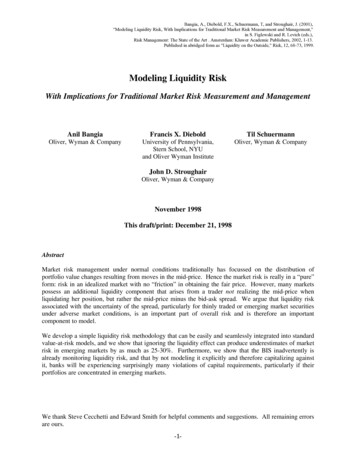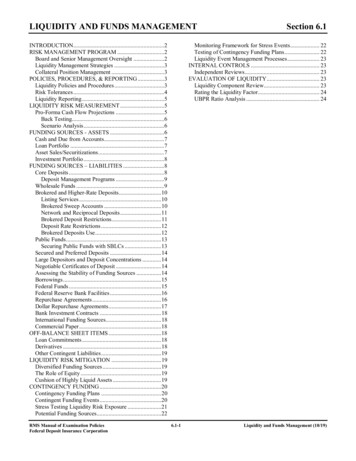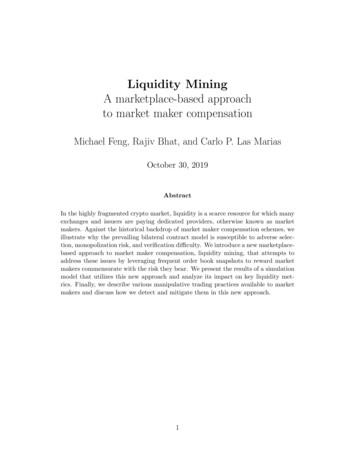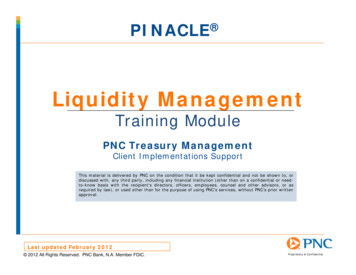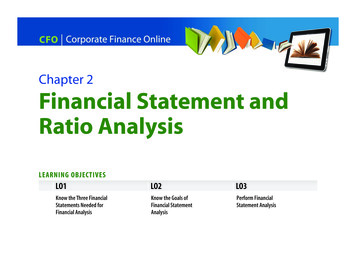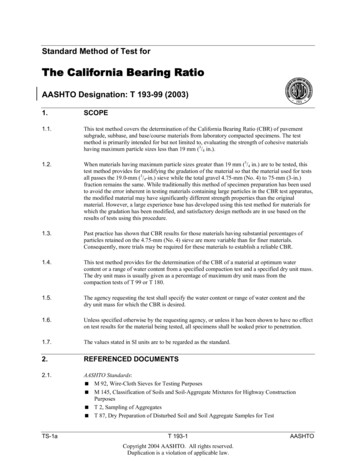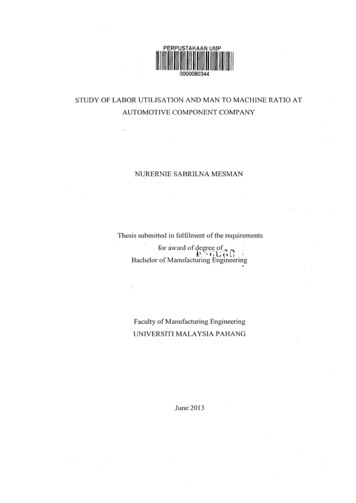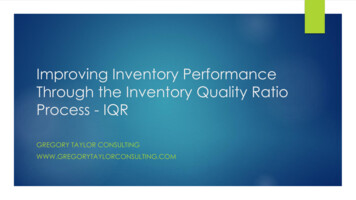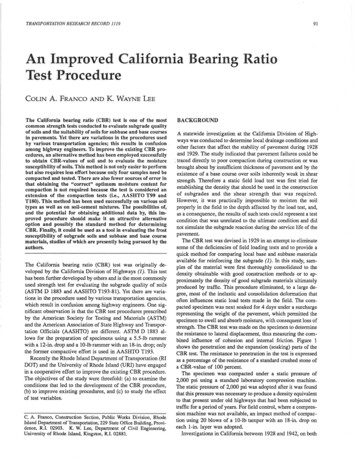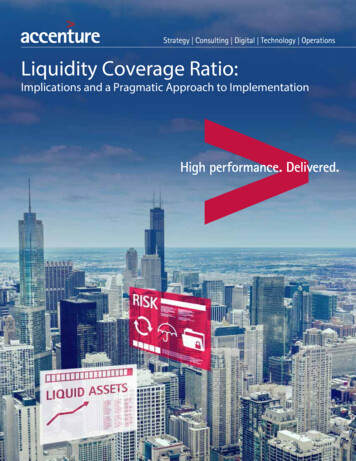
Transcription
Liquidity Coverage Ratio:Implications and a Pragmatic Approach to Implementation
IntroductionBefore the global financial crisis starting in 2008, liquidity was takenfor granted. The assumption was that funds were always available, at no(or very low) cost. Proper projection models for liquidity—as opposed to thosefor capital planning—were not very well developed. As a consequence, bankslacked strong liquidity practices, and business models such as state financingrelied upon the refinancing of long-term assets with short-term liabilities tohelp ensure profitability. The possibility of a lack of liquidity was not takenseriously, and when such scenarios did unfold it was too late for any actions.To make matters worse, short-term profitability was the only considerationdriving funding and investment decisions; the long-term need for stableliquidity and sustainable profits was neglected.As liquidity risk is one of the risk types most affected by the financial crisis,it made liquidity risk management an important strategic and tactical topic forboth banks and regulators. Banks should now understand that liquidity would beobtained at a price. This is reflected in the observable increases in liquidity spreadsexperienced during the last couple of years. Due to this, and for the foreseeablefuture, there may be very few “lenders of last resort” in liquidity crisis situations,and liquidity should remain on bankers’ priority lists for some time to come.12
Liquidity Coverage RatioIn December 2010, the Basel committeeintroduced liquidity standards as a part ofthe Basel III capital regime, including theliquidity coverage ratio (LCR) and the netstable funding ratio (NSFR).2 The effect wasto increase banks’ short- and long-termresilience. The LCR addresses whetherbanks have adequate high quality assets tosurvive stressed liquidity conditions overa 30-day period, while the NSFR guidesbanks to adopt more stable sources offunding over the long-term. In addition tothese two ratios, the Basel III initiative alsointroduced monitoring tools to track thediversification of funding sources, identifyencumbrances on assets, and facilitatedisclosure to supervisors.3At the end of 2013 the US FederalReserve System (“the Fed”) followedthese international initiatives byissuing its own mandatory liquidity rule.While using the term liquidity coverageratio with slightly different definitions ofdetails, the Fed obliges banks and otherfinancial companies to have availablesufficient short-term liquidity (high-qualityliquid assets or HQLA) to cover short-termliquidity requirements. These requirementsare defined as the net outflows overa 30-day time horizon under an acuteliquidity stress scenario for the bank and themarket. As in similar concepts the availableliquidity must exceed the required liquidity,meaning the LCR must be at least 100%.4LCR Stock of HQLAFigure 1 below provides a timeline for theLCR percentage coverage required by banks.Figure 2 provides a timeline for the LCRreporting frequency required by banks.This new regulation mandates a dailyassessment of liquidity, raising many issuesof data availability and quality.8 As the keyperformance indicator (KPI), LCR becomesa function of a variety of elements suchas balance sheet positions, the client andbusiness partner stock, or the geographicsetup of a company.The “stock of HQLA” contains assets ofonly the highest credit and liquidity quality,such as US Treasury securities. For thedenominator, the netted cash in- andoutflows are considered with a prudentminimum of 25% of the cash outflows(that is, the cash inflows are capped at 75%of the cash outflows).5 This conservativedefinition helps ensure that a bank never hasto rely exclusively on expected inflows.Figure 1. LCR percentage coverage timeline6Transition PeriodLiquidity Coverage Ratio80%Calendar year 201590%Calendar year 2016Calendar year 2017and thereafter100%Figure 2. LCR reporting frequency7Total assets 250bn or 10bn in on-balance sheetforeign exposureTotal assets 50bn but 250bnJanuary 1, 2015 June 30, 2015July 1, 2015 June 30, 2016July 1, 2016and thereafterTotal consolidated assets 700bnor assets under custody 10 tnMonthlyDailyDailyTotal consolidated assets 250bnor total on-balance sheet foreignexposure 10 bnMonthlyMonthlyDailyMonthlyMonthlyMonthly3
Key ConsiderationsThrough our work with clients in Europeand the US, including global Tier 1investment banks, global retail banks,and financial holding companies and theirsubsidiaries, we have identified a number ofkey challenges clients consistently face inmeeting regulatory mandates.In implementing an LCR project, theseshould be categorized and dealt with indistinct phases, including:Challenge Regulatory interpretation of rulesand intentions; Gap assessment of the client’s data,tools, processes and controls;The table below summarizes thesechallenges and identifies the phase wheneach challenge should be addressed: Technical implementation of thecalculations (including initial complianceas well as sustainable usability of theimplemented solution); and Embedding the LCR concept intoliquidity management as well asbroader stress testing and balancesheet management.DescriptionCompleteness of balancesheet or cash flow itemsA pure balance sheet view might not be sufficient for deriving all necessary cash in- oroutflows. Accounting treatments very often do not reflect the real cash flow behavior (e.g.amortization schemes); therefore interpretation work has to be done to deduct cash flowsfrom Generally Accepted Accounting Principles (GAAP) or International Financial ReportingStandards (IFRS) values.Maturity of quantitativemodelsVery often the necessary models for creating cash flow patterns for complex products suchas loans, mortgages and derivatives either do not exist or are not fully available. Whenmodels do exist, they are often used across units and tasks such as pricing, reporting, andrisk calculation in a way that can lead to ambiguity and uncertainty.Realization ionSimilarly, models used for the calculation of collateral value (margins) might not beimmediately available when it comes to LCR reporting purposes.Lack of clarity ofregulatory guidanceIn some parts the LCR rule has redundant, vague or even contradictory prescriptions leavingto the client’s discretion how to specifically treat some of the balance sheet items.Data availabilitySpecific attributes necessary for the correct data mapping of products according to therule’s distinctions may be missing. Other frequently encountered data shortcomings includeinsufficient frequency of updates, reliance on third parties with lack of data completeness,and poor data quality as well as missing data history (which might be needed for internal orregulatory-driven modeling).Handling a (complex)group structureAs LCR rules primarily cover big financial or banking groups, we have experienced severalchallenges related to the complex structures of these client types. The challenges includethe proper separation and treatment of intra-group business and the definition ofmateriality levels that reflect the size of the respective subsidiaries.Accessibility to internalsubject matter experts andsenior managementClient subject matter experts (SMEs) are crucial for various areas related to product, dataand tool-related knowledge, such as comprehension of client-specific products andprocesses, clarification of accounting specifics, and data completeness or granularity issues.Typically the SMEs are engaged in parallel projects and work streams in addition to theirday-to-day assignment. Proper planning of SME workshops and in-time involvement whileleveraging external knowledge to minimize the demand for internal SMEs is a key successfactor. Similarly, senior management availability for decision making whenever necessaryis encouraged.Source: Accenture, February 20154RegulatoryinterpretationGap assessmentand technicalimplementationAll phasesAll phases
5
Regulatory InterpretationAs with most regulatory requirements, the LCR requirements establishedby the Fed follow a “one-size-fits-all” approach. As previously described,due to widely varying product features as well as the range of business modelsused by different banks, many of the specific rules are open to interpretation.When interpreting the rules based on a bank’s specific business and operatingmodel, it is advisable to start with a complete (liquidity) balance sheet, includingoff balance sheet positions. In this context, the pure balance sheet values, andmore importantly, all cash flows linked to the respective positions should beconsidered. This helps achieve a consistent treatment of the balance sheet itemsas well as a thorough interpretation in light of the existing business. This approachcan be complemented by including possible new business items, in case they differin their liquidity characteristics from the existing ones. Another important aspectin our view is the need to remain consistent with other regulatory filings such asFR Y-9C, Comprehensive Capital Analysis and Review (CCAR), Basel and others.In defining guiding principles best suited to a covered company’s business andoperating model, we have taken a structured approach to appropriately interpretthe regulation, list possible options, evaluate these options and develop a suitableLCR treatment for each rule.The two examples on the following page illustrate this approach.6
Example 1:Asset-Backed SecuritiesBanks might hold asset-backed securitiesthat are collateralized by accountsreceivable. Contracts require thesebanks to prefund the debt maturity inadvance, prior to the actual maturitydate. The prefunded amount is usuallyclassified as restricted cash.The rules related to these securitiesare not clear and there is no specificguidance for such a scenario. Thereare at least two options that banksmay consider for defining outflowswithin the LCR calculation:Option 1: Apply an outflow of 100%on the date of maturity and an inflowof the same amount due to release ofrestricted cash. Restricted cash, prior toExample 2:Brokered Deposits forRetail CustomersThe outflow rates on deposits aredetermined by the end customerand not by the broker who issuesthe deposits. The broker is only anintermediary regardless of its wholesalestatus. The regulation describestwo scenarios for retail brokeredcertificates of deposits (CDs):9Scenario 1: A 10% outflow rate whenthe brokered CDs are not maturingwithin 30 days of the calculation date. Rationale: Despite a contractualmaturity date that is more than 30 daysaway from the calculation date, somecustomers may opt for early withdrawalin times of liquidity stress, regardlessof the early withdrawal penalty.the maturity date, will not be consideredas inflow due to liquidity restrictions.prefunding is done and such balancesare not available for liquidity needs.While this option is the most obvious,it does not take into account the cashoutflows for prefunding, which are acontractual requirement. In this option, nonet outflow has been applied to the LCRcalculation through the life of the security.On the date of maturity, the outflow forthe debt maturity is offset by the inflowfrom the release of restricted cash.As an additional consideration, actualprefunding is usually based on a percentageof actual account receivables and, giventhat actual account receivables arenot available in advance, a historicalanalysis is recommended to estimatethe prefunding schedule and, outflows.Consequently, the estimated prefundingwould need to be adjusted on a dailybasis when actual prefunding starts.We usually recommend this option.Option 2: Apply an outflow based onthe prefunding schedule; no outflowor inflow will be applied on the date ofmaturity, as the payment to debt holdersis netted off from the release of prefundedbalance and/or restricted cash reserve.This option allows for an outflow basedon operational characteristics and is moreconsistent with the rule’s requirements,where an outflow is applied on days when Application: Applicable to retail brokeredCDs with a maturity date more than30 days from the calculation date.Scenario 2: A 100% outflow ratewhen the brokered CDs mature within30 days of the calculation date. Rationale: In times of liquidity stress,all customers will withdraw depositsthat mature within the next 30 days. Application: Applicable to retailbrokered CDs with a maturitydate less than or equal to 30 daysfrom the calculation date.Treatment Options for Brokered CDs:Treatment Option 1: Consider brokeredCDs to be retail and fully insured–consistent with FR Y-9C reporting andthe fact brokers are instructed by thebank to sell only to individuals andto restrict deposits to 250,000. Implication: The outflow rate wouldbe 10% for CDs maturing after 30days and 100% for CDs maturingwithin the next 30 days.Treatment Option 2 (conservative view):Some brokered CDs are with wholesalecustomers and, since it is not possibleto distinguish such accounts, theconservative view would require that theportfolio be considered as wholesale,and also to assume that no counterpartyinformation is currently available. Implication: The outflow rate will be40% for deposits from non-financialentities and 100% from financialentities (regardless of maturity date).In our view, Option 1 is therecommended avenue to considerdue to the immaterial nature ofpossible wholesale counterparties.7
Gap Assessment and Technical ImplementationIn our experience, organizations have approached theassessment and interpretation phase in two steps:1. Initial compliance: This is a tactical solution to help provide LCRcompliance within stringent regulatory timelines. Typically, thisis an ad hoc solution wherein ongoing improvements should betracked with a view to developing a sustainable model.2. Sustainable model: This is a strategic solution to help integrate LCRcompliance within the broader technology infrastructure and theorganizational operating model, and align LCR compliance with other ongoingenterprise level regulatory programs such as BCBS 239 and CCAR.A lack of time or of available high quality data may require firms totake the initial compliance approach. Organizations doing so need toacknowledge the limitations of the solution and maintain a view of astrategic roadmap for developing a sustainable model. The followingitems should be considered as part of the strategic roadmap: Reduction of manual intervention—in data sourcing and report production Removal of data gaps—with enhanced data availability on a daily basis Enhanced LCR reporting and analytical tools—build/buy/extend to automatedata sourcing and reconciliation, leading to an enhanced reporting capabilityThe suggested program methodology is not necessarily exhaustive, butit is based on international experience with a range of clients, includingglobal Tier 1 investment banks and global retail banks. Different clientspresent different challenges due to the nature of their businessesand the often complex nature of their balance sheets. The followingmethodology is a tested blueprint for LCR implementation, whether theclient seeks to perform initial compliance or a sustainable model.8
Gap AssessmentThe objective of the gap assessment phaseis to help understand the impact on theclient of the rule implementation. The keydeliverable should be the documentation ofthe impact of regulatory guidance on LCRproduction, as well as identification of keychallenges and proposed next steps.Conduct Gap AssessmentOnce it is known which LCR requirementsaffect the client, it is possible to assesswhether the client currently satisfies theserequirements. In some instances therecould be no gap; for example, when theclient holds certain assets and is able toreport the exact value of these assetsas part of the LCR calculation. In otherinstances a gap may exist. This may happenwhen the client is aware of outflowsrelated to certain products, but a detailedbreakdown of the products is not availablefor the purpose of LCR reporting. The gapsidentified feed the implementation phase ofthe program.Document Interpretations and GapAssessmentRegulatory interpretations, along withthe results of the gap assessment,should be documented to a standardthat can be shared with the regulator.If any assumptions are made in relationto the treatment of assets, outflows,and inflows, the regulator will expect adetailed rationale. In addition to satisfyingthe regulator, this deliverable should actas a point of reference throughout theimplementation phase of the program.It should be considered a living documentand updated whenever new decisions aremade or assumptions are revisited.9
Technical ImplementationThe objective of the technicalimplementation phase is to source allthe data required for the LCR calculationand to implement a reporting routine.The key deliverable is a functioning toolcapable of running the LCR calculation,1Create solution blueprint2as well as a reporting structure(which includes analytics). This phaseof the program can be broken downinto the following key activities:Build reporting tool/partner vendor software3Test data and designcontrol framework4Develop reporting routineSource: Accenture, February 2015Create a Solution BlueprintBuild a Reporting ToolThis activity includes the developmentof an LCR data sourcing structure (sourcesystems and exact data attributes)as well as a mechanism for interactionwith the responsible stakeholders.These stakeholders might include data andprocess owners for various product groups,as well as central finance areas such asregulatory reporting or accounting. A lackof data, as well as the unavailability of keystakeholders, can be among the challengesfaced in creating such a blueprint.As seen in Figure 3, a reportingarchitecture is complex and multi-faceted.Multiple data sources, both automatedand manual, are used to gather theinformation required to run the LCRcalculation. This data must be transformedinto a format that can be used for LCRreporting. For example, maturity datesare used to create total inflows/outflowsfor each asset class and for each of the30 days. This data may be adjusted fortechnology errors or for known data gapsthrough a governed process, completewith audit trail. The calculation is thenrun applying the runoff rates as definedby the regulator.Figure 3. Typical solution design for LCR reportingSolution DesignLand Raw DataLCR CalculatorData AdjustmentReport GenerationAutomatedData SourceAutomatedData SourceManual FileUploadTransform toLCR cash flowformatted dataLCR CalculationManual FileUploadAccess, Security and PerformanceReconciliationSource: Accenture, February 201510Entity 2AutomatedData SourceData TransformationEntity 3Data Sourcing
Similar architectures have beenimplemented at our clients using varioustools, from spreadsheets to custom builtsolutions to vendor software solutions.In our experience, there is no single systemcovering all requirements, especially if theLCR solution is embedded into a broaderliquidity management system architecture.An integrated solution (such as the oneshown in Figure 4) can help a companycope with other regulations such as therequirements set out by BCBS 239 (RiskData Aggregation and Reporting Principles).All liquidity risk data is sourced and storedin one repository, with a comprehensivereporting capability running off the data.The reporting capability should help reducemany of the manual processes involved inproducing and reconciling the reports, aswell as providing greater confidence in thedata through automated reconciliation tothe general ledger, which is particularlyimportant for accurate forecasting.Test Data and Design ControlFrameworkDevelop a Reporting RoutineTesting the completeness and accuracy ofall sourced data is important for confirminga quality LCR calculation. For any manualsources, checks and balances should beinstal
Figure 1 below provides a timeline for the LCR percentage coverage required by banks. . Calendar year 2016 Calendar year 2015 100% 90% 80% Figure 1. LCR percentage coverage timeline6 . Comprehensive Capital Analysis and Review (CCAR), Basel and others. In defining guiding p
